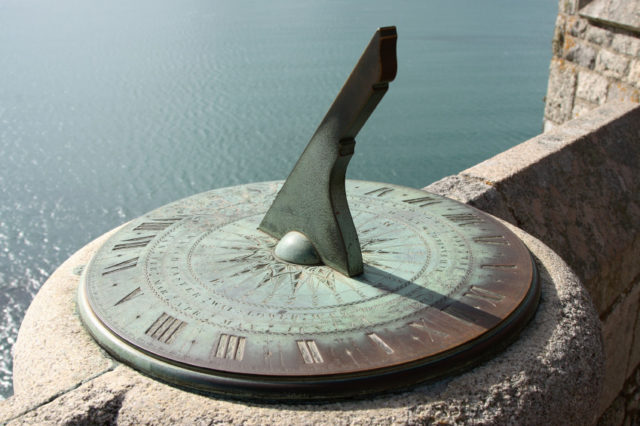When we think of the ancient Egyptians we think of pyramids, sphinxes and King Tut. But the Egyptians didn’t just create spectacular monuments for us to take countless pictures of — they also invented some everyday stuff that we take for granted in modern times.
10. Toothpaste
Life was hard on teeth back in ancient Egypt, but citizens sure tried their best when it came to oral health. Not only were toothpicks discovered in ancient tombs, Egyptians also created their own toothpaste to keep those pearly whites as perfect as they could be.
The first attempts at cleaning teeth included a powder made from myrrh, egg shells, pumice and oxen hooves. But a fourth century AD document discovered in a Viennese museum basement is thought to be the world’s first known toothpaste formula. The Egyptians would crush and mix rock salt, mint, dried iris flower and pepper to make their paste, which was a far cry from your average Colgate. It seems the Egyptians may have been on to something when they chose to add iris flower into their toothpaste though, as dentists now believe it’s effective in fighting gum disease.
9. Calendars
Calendars are an essential part of keeping us organized, whether it’s a smartphone app or a kitten a day desk calendar. But it was the ancient Egyptians who created the first 365 day calendar. With farming being such an important part of Egyptian society, one flood could mean a whole lot of devastation. In order to know when the best and worst times would be they kept records of Nile River floods, and created a calendar to track when the worst floods would occur. They worked this out by studying the star Sirius, which would appear at the time the Nile would begin to flood.
The Egyptian calendar wasn’t split into the typical seasons we have now, but into three farming seasons: inundation, growing and harvest. Their seasons were divided into four months of 30 days each, with an extra five days added between harvest and inundation for religious celebrations.
8. Eyeliner
You can’t go out in public today without seeing a woman wearing eyeliner, or a man if you’re at a bad concert. For many, it’s a cosmetic essential. But forget L’Oreal and Maybelline — it was the Egyptians that first provided us with those trademark black-rimmed eyes.
Egyptians created “kohl” by crushing and mixing a variety of ingredients ranging from black copper oxide to burnt almonds, and stored the result inside small granite pots. They started the famous trend of lining eyes with kohl in order to recreate the image of Ra, the sun God. But Egyptians didn’t use kohl just to make a fashion statement. The eyeliner was useful for keeping bacteria out of their eyes and stopping nasty infections. It was also effective in preventing the glare from the sun affecting their eyesight.
7. Written Language
We might not be drawing a bunch of hieroglyphics on papyrus anymore, but today’s written language does trace back to ancient Egypt. Although the use of drawings to tell stories came from an earlier time period, it wasn’t considered written language until the Egyptians began to use pictograms to represent words. This led to the creation of hieroglyphs, which were used on temples, sculptures and in tombs. A symbol could either stand for the object as a whole, an ideogram, or as a sound, a phonogram.
Hieroglyphs would often tell stories of contemporary politics and culture, helping us learn what information we now know about life in ancient Egypt. Deciphering hieroglyphs became possible after the discovery of the Rosetta Stone in 1799.
6. Mints
Where would we be without a Tic Tac or a Mentos to get rid of our coffee breath in the morning? Again, we can thank the Egyptians for that quick solution to all the not-so-pleasant smelling products we consume.
Dental issues were a huge problem in ancient Egypt. The bread citizens ate was full of grit and other substances that quickly wore down teeth, and the lack of adequate dental care (aside from that toothpaste) often led to decay. This meant their breath wasn’t so great, and bad breath was often a symbol of low income. So they dealt with it by creating the world’s first mint. The mint was shaped like a pellet, containing a combination of frankincense, myrrh and cinnamon boiled with honey. The mint proved effective in eliminating the foul odors that plagued the mouths of citizens, and presumably saved many a date night.
5. Door Lock
You can thank Egyptians for the fact that people aren’t just walking into your home right now and stealing all your toothpaste and mints. The oldest door lock found is thought to be 4000 years old and was discovered in an Egyptian palace. The first examples of locks in Egypt were wooden bolts that had slots containing holes for pegs to drop into. The key for the door would have another set of pegs that would raise the pegs inside the lock when the key was inserted. The Romans followed the Egyptian’s techniques and developed metal locks based on the original wooden designs. The pegging system created by the Egyptians is similar to the system we still use in locks today.
4. Mathematics
Depending on your grades in high school this is something you might not want to actually thank the Egyptians for, but they did help shape modern mathematics. We use math all the time, no matter how much we despise it, whether it’s organizing our finances or simply adding up our shopping baskets. Math was needed for the Egyptians to develop their buildings and monuments, and it was also used to help manage the distribution of food supplies amongst citizens.
The Egyptians created an instruction manual for geometry that gave demonstrations for division and multiplication. The 1650 BC manual was named the Rhind papyrus, and was discovered by Egyptologist Henry Rhind in the 19th century. It contained around 84 mathematical problems and solutions, including how to distribute bread among a workforce. So you can blame the Egyptians next time you have to do some equations.
3. Shaving
They might not have had the simple, electrical hair removers of today, but the Egyptians were the first people to have a shave. Personal appearance and hygiene was of great importance in ancient Egypt, and getting rid of unwanted body hair was a must. Egyptians removed most of their body hair expect for their eyebrows, and often replaced head hair with a wig. Having facial scruff was considered shameful and a symbol of neglect.
Shaving wasn’t just for appearances — being hairless meant it was easier to stop the spreading of lice and disease. Hair removal would include applying various depilatory creams, or rubbing it off with a sharpened stone. So the next time you have to drag yourself off to the bathroom for a shave, be thankful you have a razor instead of a rock.
2. The Clock
The Egyptians didn’t have a watch or a phone that they could check every few minutes to see the exact time, but it’s down to them that we have that luxury. The ancient Egyptians were amongst the first people to formally divide the day into hours with a sun clock created from a monument known as an obelisk. It provided a shadow which allowed Egyptians to split the day into two parts: before and after noon. This also showed when it was the longest or shortest day of the year.
This was followed by the water clock, which was invented by an Egyptian court official named Amenemhet. Water would be placed in a bowl that had hours marked down the side, and the time would be measured as the water level changed.
1. Condoms
Yes, that’s right. We have the ancient Egyptians to thank for safe sex. An Egyptian painting from as early as 1350 BC displayed men sporting a sheath in a similar design to modern condoms. But instead of using the sheaths for safe sex they were used more for hygiene. The material would help to protect against infectious diseases, and to stop insects from getting into those unwanted areas.
It’s also speculated that they were worn as part of a ritual, or served as a symbol of higher social status, but there’s no surviving documentation to prove it. Either way, their design and innovation is part of today’s most effective birth control, even if it was just to keep the creepy crawlies out.










3 Comments
jk
Babylonians are also the first to use arithmetic , which is what you really meant to say. Basic adding and subtracting is an anti-deluvian (Upper paleolithic [10,000 to 50,000 B.C.E.]) practice.
Sorry, you got a few wrong. Written language, calendars and eyeliner originated in the Chaldea region in and around Babylon.
Egyptian was a fully formed and realized language. Akkadian is the oldest written language, which originated in the area of Babylon. Babylonians were the first pyramid builders as well.